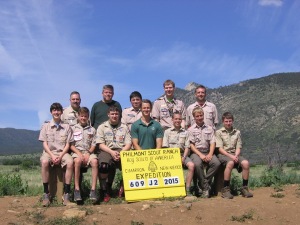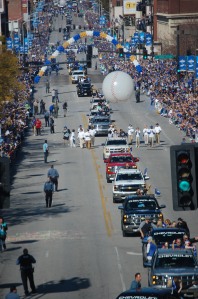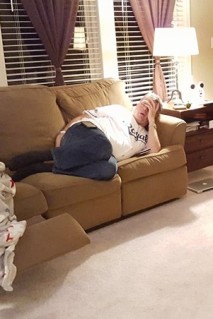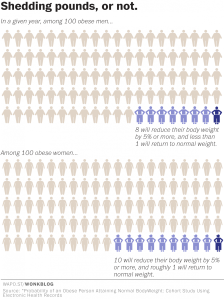Note: When Wil and I were at Philmont Scout Ranch in June, we were given little notebooks and encouraged to keep a log and record our thoughts. I took some pretty extensive notes, and thought I might turn them into a journal, perhaps annotated with pictures, which I might post online if anyone is interested. While I started my notes at Day 1, my Philmont journey is not complete without including my journey that led up to Philmont. What follows will be the opening part of that journal.
Day -157: Today is the day I got serious about preparing for Philmont. We signed up to go to Philmont almost a year before. At that time, the experience of hiking in Utah after having lost a significant amount of weight was fresh on my mind. I knew that I would need to lose more weight to be ready for Philmont–that Philmont had strict height-and-weight standards, but that challenge seemed manageable. However, over the rest of 2014, my weight moved the wrong direction. Still, I arrived at December 1 (Day -189) needing to lose something like 39 pounds over about 6 1/2 months. It would require work, but it seemed manageable. However, it would require losing at least some weight in December, something that seemed about as impossible to pull off as the roommate switch from Seinfeld. But I felt that if I could get to January 1 needing only about 30 pounds to lose in half a year, I would be in great shape.*
*OK, not great shape. I mean, I’d be out of shape. But I’d be in good position to be in shape–or at least in shape enough to meet the height/weight requirements.
But that morning I was confronted with the stark realization that peanut brittle, Christmas cookies, and office holiday party fare are not, in fact, diet food. I gained weight in December. I was looking at having to lose more than 50 pounds by early June. While not impossible, I knew it was going to be a real challenge.
Day -148: Preparing for Philmont means getting in Philmont shape. Getting in Philmont shape involves both meeting the weight requirements, and getting accustomed to long hikes carrying sufficient weight. Crews (groups of Scouts and their adult advisors–usually from the same troop–going through Philmont together) are advised to take a number of practice hikes. Crews are encouraged to take these hikes of increasing length, and with weight comparable to what they will be carrying at Philmont (about 35-45 pounds per person). This day was the first practice hike for me. While we were encouraged to carry all of the gear that we would be carrying at Philmont, I hadn’t bought a backpack yet, so I had to improvise by carrying a smaller backpack, like those students carry their books in. I stuffed about 25 pounds of weights into the bag, hoping that it would reasonably simulate what I would experience at Philmont.
It was a rare comfortable Sunday afternoon in January. The course we had chosen had a number of changes in elevation, which we hoped would help to simulate what we would experience at Philmont. The difficulty of the course, and the fact that this was the first training hike for most of us held up our progress. We had planned to hike for about eight miles, but our crew moved more slowly than we had planned, and completed only about 4.5 miles. Nevertheless, by the end of the hike, I was worn out. I was sore all over–my back, my knees, my ankles, and my feet. The thought of having to hike again filled me with dread, and I worried about how I would feel the next day. I couldn’t fathom ten straight days of hiking, which was what we would be doing at Philmont. Completing our 62-mile trek (the Philmont term for our itinerary) seemed impossible. On the way home from the hike, the apparent impossibility of completing a multi-day hike, coupled with the daunting weight loss challenge had me convinced that I had made the worst mistake of my life. I began thinking about ways I could back out. Just about he only thing that held me back was the knowledge that I had already paid the sizable non-refundable registration fee.
Day -147: I was still sore from the previous day’s hike, and still wondering how I would be able to complete hikes on consecutive days, let alone ten straight days. I was also still focused on the weight loss challenge, but I did re-check the height and weight requirements, and got a mildly pleasant surprise that the weight limit was a few pounds higher than I thought it was. As of this day, I needed to lose 40 pounds in 147 days–challenging, but achievable.
Day -120: We took our second practice hike as a crew on this day. A couple of weeks earlier, I had hiked for a couple of hours with the family, which went better. Of course, I wasn’t hiking with weights, and the terrain was both smoother and less hilly that what we had done on our practice hike. Nevertheless, I was encouraged. The weather for this day’s hike was nice again, but it followed a week of precipitation, and the trail was very muddy, which slowed us down considerably, keeping our distance hiked low–only about 2.8 miles. What was most remarkable about this hike, however, was how the muddy trails required so much more effort on each step. With the unstable footing, we found ourselves sliding every time we had to put our feet down, and had to expend considerable energy on each step to keep from sliding. I ended up sore and tired, but not thoroughly wiped out. I was encouraged, but I kept in the back of my mind that we covered very little distance at a slow pace, and we would have to do more distance faster to be ready for Philmont. And, having lost more than 15 pounds, I was feeling somewhat better about meeting the weight requirement.
Day -100: Shortly after the good feelings about weight and the second practice hike, I hit a stumbling block–Valentine’s Day. I gained a couple of pounds that weekend, which seemed to take forever to take off again. I realized that the I could not afford setbacks like this–no matter how small–with the timeline I was faced with. Two months into the year (and the weight loss), I had lost 17 pounds. I needed to lose 32 more over three months, leaving me little room for error.
Day -92: This was the third practice hike with the crew, and also marked exactly three months until our first day at Philmont. We were hiking at a different location on a trail that was much flatter than our first couple of hikes. This was also my first hike with my new backpack. Our course took us on a nearly five mile hike–the longest hike I had been on. I remember being tired at the end of the hike–more tired than I felt I should be, knowing that we would have longer hikes most days at Philmont–but less tired that I was for the first couple of hikes. I was encouraged that the backpack distributed the weight I had to carry much more effectively, but I also wondered how much of the difference in how I felt was due to the easier terrain. With three months left, I still needed to lose 29 pounds–basically ten pounds per month, a pace that I had been able to pull off before.
Day -91: My weight loss plan is built on counting calories and increasing my exercise. Hike days are days when I expend a lot of calories, and therefore, I should see weight loss on those days. I do increase my caloric intake slightly on hike days–snacks on the trail for energy–and view my phone apps’ estimates of calories burned very skeptically, but I’m certain that I still rack up huge calorie deficits on those days. However, the day after each of the last two hikes, I ended up showing a weight gain. I was counting on these hikes to help accelerate the weight loss.
Day -81: The scheduled crew hikes were becoming more frequent. This hike was back on the original trail–the bridle trail around Wyandotte County Lake, and was planned to be longer–this time entirely circling the lake. I’m not sure what the final mileage was (I shut off the app at 7.61 miles with still about a quarter of the hike remaining). In each of our previous practice hikes, I had “hit the wall” near the end of each hike, reaching a point where it was difficult to continue. This hike also had its wall, which hit me about the same time I shut off my phone. It was as if my energy was tied to the battery level on my phone, so that when I noticed the phone was running low, my energy left me. The last two-or-so miles were incredibly difficult–so difficult, that I told the rest of the crew to go on ahead, leaving me to finish at my own slow pace. Each time I have hit the wall, the experience has been different. Every wall has been marked by fatigue–a total lack of energy–along with (and perhaps caused by) a different part of my body being painful. On the first hike it was my ankles and knees. The second hike seemed to hurt my hips, and my ankles were also sore. I was determined to fix the ankle problem with new boots, which I was breaking in on this third hike. I had previously been wearing low-top hiking boots, so my new boots were higher, giving more ankle support. They seemed to help with the ankle pain, but because they were brand new and not broken in, I ended up with painful blisters on both feet.
Day -69: The next dietary stumbling block was a conference I attend in Washington, DC every year. The trip comes with all kinds of threats: snacks on the airplane, unhealthy meals, receptions, snacks during conference breaks, and exhibitors that draw attendees to their booths with big bowls of candy. I’ve written before about the challenges I face when I go to this annual conference. Again, with around 20 pounds still to lose in just over two months, I couldn’t afford to have a significant setback. I ended up gaining two pounds in the five days of the conference, which was disappointing, but not yet a crisis. But it was encouraging that I was able to lose those two pounds in just three days.
This trip was also significant because of the practice hike that I missed. While I didn’t go, Wil did, and he came back limping. He had stumbled a couple of times and apparently hurt himself. He was still able to walk–albeit with a limp–so we didn’t take him to a doctor until a few days letter, when his leg didn’t seem to be improving. Eventually, we found out that he had a stress fracture in his femur. Suddenly, Wil’s trip to Philmont–and probably mine, since Wil was the main reason I wanted to go–was in jeopardy.
Day -60: The next practice hike was scheduled for a weekend campout. I went without Wil, since he was on crutches and was ordered not to put any weight on his broken leg. The hike was on a rocky trail at Elk City Lake near Independence, KS. We drove to the lake on Friday evening, camped overnight, and got up the next morning to begin our hike. The trail was a good test for Philmont, because it was very rocky. Although the trail didn’t involve significant elevation changes, the rocky terrain slowed us down and wore us down. By the end of our approximately nine mile hike, I was nearly as worn out as I had been on any of our other hikes. Upon returning to my tent, I bent down to take off my boots, and was hit with with cramps in my quads. This was an all-too-common occurrence for me: I developed cramps within a couple of hours of many of my practice hikes, and would often get cramps in the middle of the night when camping. I knew that not being sufficiently hydrated can cause cramping, but I thought I was being careful to drink enough water during the hikes. The frequency of cramps, both following hikes and while camping, was another reason to be concerned about Philmont.
Day -43: Less than a month-and-a-half before our departure, I visited the doctor both because I was due for my annual physical, and because I needed to have him complete the physical form that had to be turned in to Philmont. A key element of this form is the certification of my height and weight. I knew that I wouldn’t make weight by the time of this appointment, but also knew that the “official” weigh-in would occur at Philmont, so I wasn’t overly concerned. But the appointment gave me new reasons to be concerned. It started when I called to set the appointment and learned that the doctor I had seen for the past ten years was no longer with the practice. I had to make the appointment with a doctor I had never seen before. But even worse, upon checking in, I had a new reason for panic. I was counting on being measured at six feet tall, but came in at 5′ 10 1/2″. This was significant, because it lowered my target weight by six pounds, meaning that I had to lose an additional six pounds beyond what I had been counting on for several months.
So my mindset had already gone negative before the doctor even walked into the examination room. When he entered, we talked about why I was getting the physical, and the topic of Philmont came up. I learned that he had been on the medical staff at Philmont about ten years earlier,** and so he shared a lot of his Philmont knowledge with me. He told me that when he had been there, the medical staff were able to build some flexibility into the height and weight guidelines, allowing them to take into consideration recent weight loss or other factors. He encouraged me to remain positive and to continue to work, and led me to believe that I would likely be allowed to remain at Philmont even if I didn’t meet the published weight goal.***
**For 57 years, the University of Kansas School of Medicine has had its medical students (under the supervision of faculty) serve as medics at Philmont. My doctor had been one of those students a few years back. But what this means is that my new doctor had been in medical school only ten years ago. Since my previous doctor had been a few years older than I am, it was an adjustment switching to a much younger doctor.
***This conversation will figure into a future post, as well. I’ll just leave that cliffhanger here to tease you.
Day -21: I continued to lose weight, at a steady, but unspectacular rate. I found myself daily doing the mental math to compare the amount of weight I still needed to lose with the number of days remaining before Philmont, and the rate at which I had been losing weight up to this date. At the time of my physical, I had been on a rate that would allow me to reach my target weight. However, the additional six pounds that I needed to lose after the physical, coupled with what seemed to be a slowing rate of weight loss put me on a path that would see me arriving at Philmont above the maximum weight for my (now lower) height.
So I made two key changes. First, I decided to stop tracking my exercise. I thought that one of the reasons that my weight loss seemed to be slowing down might be that I was using my exercise as a reason to eat more. Tracking the exercise in My Fitness Pal raised the total number of calories I could consume in a day, and I felt that I was increasing my calorie consumption as a result. My plan was to continue to exercise as much as usual (or even increase my exercise), but not give myself the caloric credit for doing so. The second change was to stop drinking diet soda, and to substitute water (for the most part). I’ve heard conflicting stories about the effect of diet soda on weight loss, but figured that making this change couldn’t hurt.****
****I gave up diet soda for Lent. During that six-week period, I lost ten pounds, which was actually a slower rate of weight loss than my I had before and after Lent.
Day -1: Sunday, June 7 was the day we left Kansas City for Philmont. We were taking a 10:30 PM train from Kansas City to Raton, NM, so we were scheduled to meet at the train station at 9:00. One of the last things I did before leaving for the train station was to weigh myself. My weight was 6.2 pounds over my target (but only .2 pounds over what my target would have been when I thought I was 6 feet tall). I still had two days before the official weigh-in, so I thought I still had a chance to get at least close to my target weight. But that meant I would have to continue to be vigilant about my eating for the following two days.
Day 1: Philmont is considered to be a 12-day experience, but only ten days are spent in “the back country.” Day 1 and Day 12 are spent entirely at base camp. Our health check, when the final weigh-in would occur, was scheduled for the afternoon of Day 1. Between our departure from Kansas City, I had breakfast on the train, lunch at McDonald’s in Raton, and three meals in the mess hall at base camp. Of these meals, the ones in the mess hall were the toughest, because Philmont provides high calorie meals (and plenty of food). I passed up some appetizing items and ate small amounts of other things, hoping to make enough progress to at least be close to the target weight.

Our crew, on the morning of Day 1, about six hours before the weigh-in. You can almost see the nerves in my facial expression.
As the time for health check came closer, I was feeling a strange and contradictory mixture of nerves and confidence. The logical side of me thought it was unlikely that I would lose six pounds in two days, but my gut (which, let’s face it, is much bigger than my logical side) was telling me everything would be alright. Finally, it was time for my health check. The health check consisted of a review of my medical form, complete with questions about my medical history, follow-ups to items listed on the form, and–since my weight listed on the form was over the maximum allowed for my height–a re-check of my weight.
We had been conditioned to believe that the staff conducting the health checks were strict and businesslike, but I was met by a pleasant young woman. She glanced at my form and then back at me, and her first words to me were, “You’re not 6 feet? That can’t be correct.” With those words, I knew I had a friend. I mentioned that used to always consider myself to be 5’11”, but that on one visit to the doctor I had been measured at 6 feet, so that was what I had gone by until my latest physical. Her response was, “Well, let’s just check it again.” “I suppose you need to measure me without my boots,” I said. To my surprise, she told me I could leave them on. This woman is definitely a friend, I thought.
I stood against the far wall of the health check lodge, where a tape measure had been attached, hopeful. My new friend casually walked up and placed a ruler on my head, up against the tape measure. “You’re six feet tall,” she announced. I felt a strong sense of relief, but the real moment of truth–the weigh in–could take that away pretty quickly. And that weigh-in was the only thing left to do. My new friend asked me to head over to the scales.
Preparing for a test often involves both studying the material and developing a test-taking strategy. So too with my weigh-in. Sure, I had devoted months to losing weight, but I had also devoted considerable mental energy to how I wanted the weigh-in itself to go. Although it appeared to be a widely-held belief within our Scout troop that the final weigh-in would be conducted with boots on, all of the written material we had received from Philmont emphasized that the final weigh-in would be conducted “in stocking feet.” So before heading to the scales, I went back to the chair to remove my boots. But I didn’t stop there. My strategy was to remove as much weight that wasn’t actually me as modesty would permit (and modesty might just have to be sacrificed, too). I planned not just to remove my boots, but to empty my pockets, take off my watch, remove my belt. Kris had suggested all of those things to me in the train station, and she even advised taking off my wedding ring (you can supply your own joke here). I had even made sure that when I had gotten dressed that morning, I put on my shorts that fit most comfortably without a belt, anticipating taking it off for the weigh-in. So, after removing my boots, my watch came off, my pockets were emptied, and I even removed my wedding ring.
I headed over to the scales, stepped up on them, and immediately had an “Oh, crap!” moment. I had forgotten to remove my belt! I could end up being sent home because of the extra six ounces of leather (or a reasonable facsimile) and metal I was wearing! Helplessly, I looked down at the digital readout on the scale. The number I wanted to see was 239 pounds. The readout flashed 239.0, then 239.2, then back to 239.0, where it finally–after what seemed like a minute of wavering but was probably about three seconds–settled. I had hit the target number EXACTLY. I was going to get to stay at Philmont.




